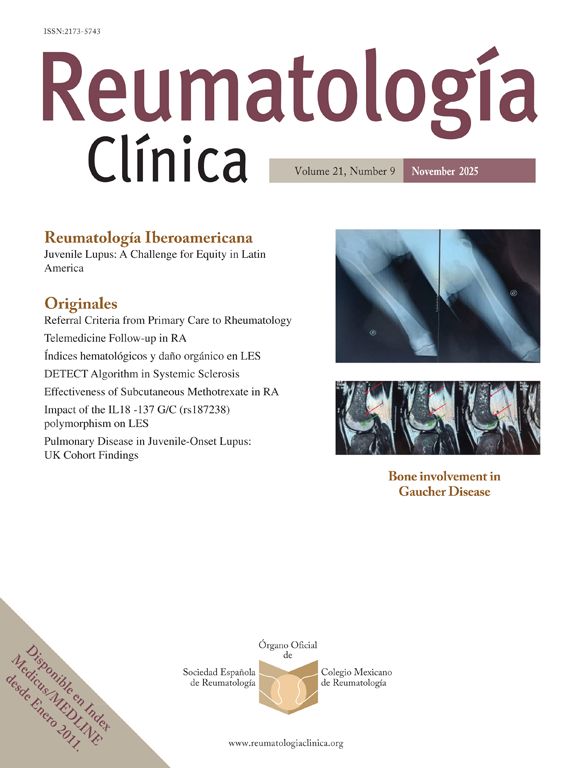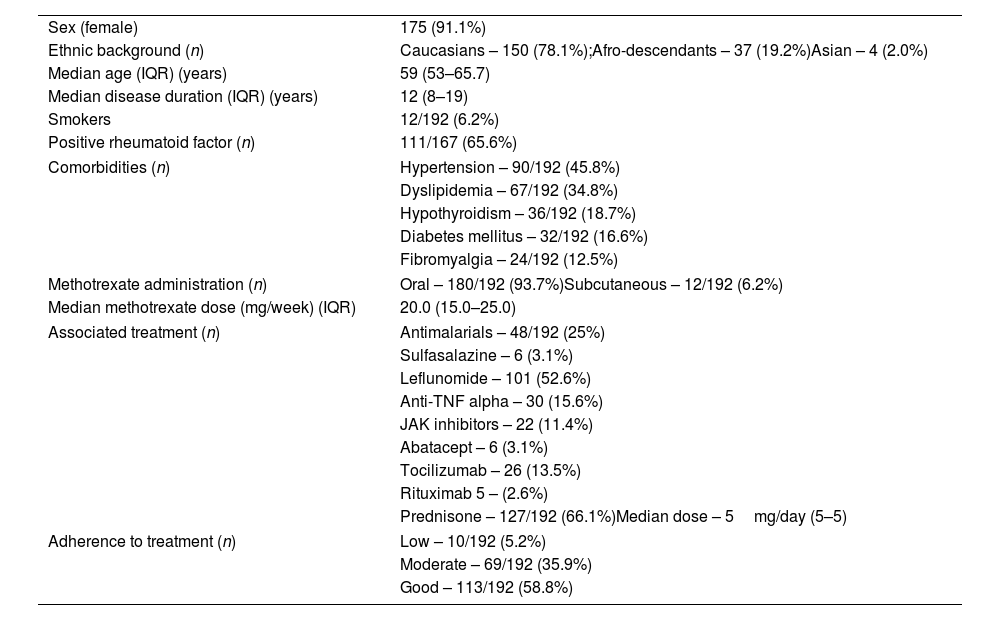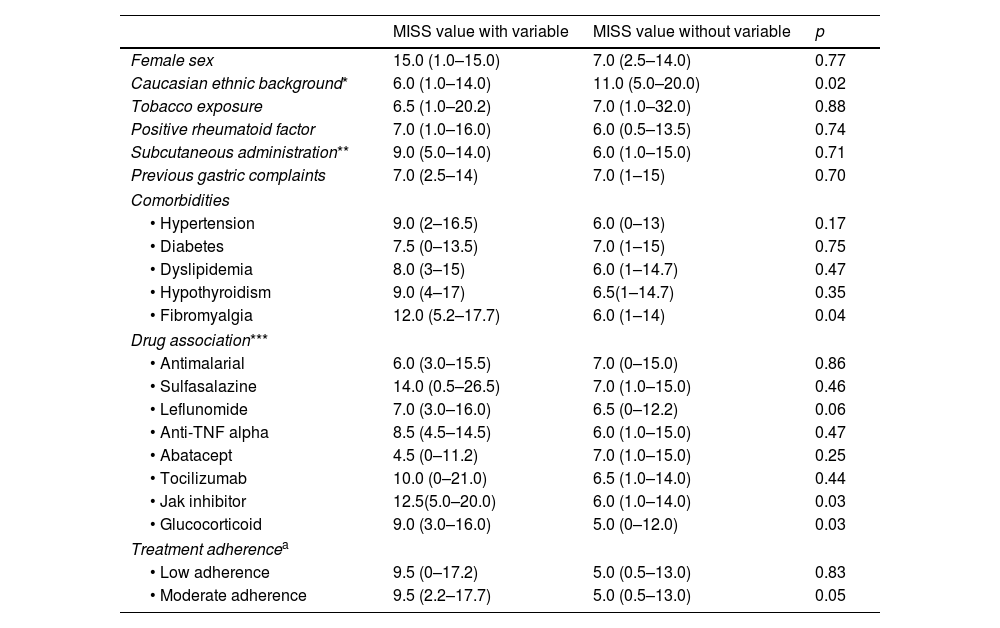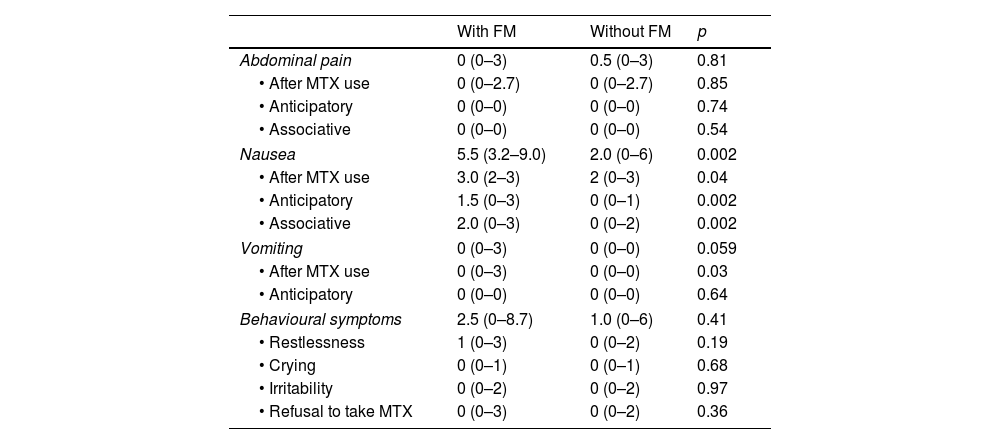Gastrointestinal intolerance is common in rheumatoid arthritis (RA) patients using methotrexate and may lead to treatment discontinuation.
AimTo study the prevalence of gastrointestinal symptoms in a sample of RA methotrexate users as well as its possible association with clinical and epidemiological variables.
MethodsCross-sectional study of 192 patients with gastrointestinal symptoms using the MISS (methotrexate intolerance severity score). Clinical and epidemiological variables were collected through chart review and direct questioning. Patients’ adherence to methotrexate was evaluated through Moriski–Green–Levin questionnaire.
ResultsThe prevalence of gastrointestinal complaints was high with 55.7% of the sample classified as intolerant. Nausea and pain after drug ingestion were the most common reported complaints. This intolerance was associated with afro-descendant background (p=0.02); presence of associated fibromyalgia (p=0.04), concomitant use of glucocorticoids (p=0.03) and Jak inhibitors (0.03). A tendency towards association with leflunomide use was observed (p=0.06). Logistic regression was used to test drug associations with methotrexate intolerance, and showed that glucocorticoid use was independently associated with methotrexate intolerance OR=1.85; 95% CI=1.01–3.44; p=0.04. Route of administration, presence of previous gastric complaints, age and methotrexate dose did not interfere with MISS. MISS results were associated with moderate adherence to the drug.
ConclusionsThere is a high rate of methotrexate intolerance that is more common in afro-descendants, those with associated fibromyalgia, glucocorticoid and Jak inhibitors users.
La intolerancia gastrointestinal es común en pacientes con artritis reumatoide (AR) que usan metotrexato y puede llevar a la interrupción del tratamiento.
ObjetivoEstudiar la prevalencia de síntomas gastrointestinales en una muestra de usuarios de metotrexato en AR, así como su posible asociación con variables clínicas y epidemiológicas.
MétodosEstudio transversal de 192 pacientes con síntomas gastrointestinales mediante el Methotrexate Intolerance Severity Score (MISS). Las variables clínicas y epidemiológicas se recogieron mediante revisión de historias clínicas y cuestionario directo. La adherencia de los pacientes al metotrexato se evaluó mediante el cuestionario Moriski-Green-Levin.
ResultadosLa prevalencia de molestias gastrointestinales fue alta, con un 55,7% de la muestra clasificados como intolerantes. Las náuseas y el dolor después de la ingestión de fármacos fueron las quejas más comunes. Esta intolerancia se asoció con el origen afrodescendiente (p=0,02); presencia de fibromialgia asociada (p=0,04) y el uso concomitante de glucocorticoides (p=0,03) e inhibidores de Jak (0,03). Se observó una tendencia a la asociación con el uso de leflunomida (p=0,06). Se utilizó la regresión logística para probar las asociaciones de medicamentos con la intolerancia al metotrexato y mostró que el uso de glucocorticoides se asoció de forma independiente con la intolerancia al metotrexato OR=1,85; IC del 95%=1,01-3,44 (p=0,04). La vía de administración, la presencia de molestias gástricas previas, la edad y la dosis de metotrexato no interfirieron con el MISS. Los resultados del MISS se asociaron con una adherencia moderada al fármaco.
ConclusionesExiste una alta tasa de intolerancia al metotrexato que es más común en personas afrodescendientes, con fibromialgia asociada, usuarios de glucocorticoides e inhibidores de Jak.
Despite significant advances in the treatment of rheumatoid arthritis (RA), with the advent of biological drugs and Jak inhibitors, methotrexate (MTX) still remains the first line of therapy.1 This drug is considered to be the “gold standard” in RA treatment, and it is also used in several other rheumatic diseases as a glucocorticoid sparing agent. It can be used as both monotherapy or in combination with other drugs, with doses normally ranging from 10–15mg/week to 25–30mg/week.2
MTX has been shown to improve signs and symptoms of RA3 and even to extend the patient's life span due to inflammation control and atheroprotective effects.4 Moreover, this drug is not only effective, but also inexpensive and accessible to the overall population.
However, MTX has mucosal, gastrointestinal, hepatic and haematological side effects that may lead to treatment interruption; among them, gastrointestinal intolerance is one of the most common.5 Folate supplementation is frequently used to treat methotrexate-associated side effects and toxicity.6
The methotrexate intolerance severity score (MISS) is an instrument specifically designed to study gastrointestinal side effects in patients using MTX; it quantifies the occurrence of abdominal pain, nausea, vomiting, and behavioural symptoms associated to the use of MTX.7
Herein a study of RA patients using MTX was conducted, using the MISS, with the purpose of examining the degree of intolerance to this drug treatment and if clinical and anthropometrical variables were associated with worsening of gastrointestinal complaints.
MethodsEthical issuesThis is a cross-sectional study, approved by the Institutional Research Ethics Committee under protocol no. 5.153.481. All participants signed an informed consent. The study was conducted according to the Good Clinical Practice guidelines and the Declaration of Helsinki.
SampleA convenience sample of RA patients who attended a Rheumatology outpatient clinic in a University Hospital for regular consultations during the period of one year, was invited to participate in the study in the order of their appointment. To be included patients had to: be older than 18 years of age, have RA according to ACR/EULAR classification criteria,8 be using MTX orally or subcutaneously, and to have intellectual capacity to understand the informed consent form. Patients with inflammatory bowel disease, neoplastic disease or using non-steroidal anti-inflammatory drugs (NSAIDs) were excluded.
At this outpatient clinic, all patients using MTX also received a prescription for folic acid, 5mg, orally, twice/week.
Data collectionThe following data were collected:
- a.
Epidemiological and clinical RA data – obtained through chart review or upon direct questioning (age, sex, auto declared ethnic background, tabaco use, disease duration, MTX dose and treatment duration, presence of rheumatoid factor; comorbidities and associated treatments).
- b.
History of gastrointestinal symptoms prior to MTX introduction using a Yes/No answer.
- c.
Methotrexate intolerance severity score (MISS) – this instrument includes the following domains: abdominal pain (with three questions: pain after MTX use, anticipatory pain and associative pain), nausea (with three questions: nausea after MTX use, anticipatory nausea and associative nausea), vomiting (with two questions: vomiting after MTX and anticipatory vomiting), and behavioural complaints (with four questions: restlessness, crying, irritability and refusal to take the MTX). Each symptom is assessed after MTX administration, several hours to 1 day before taking MTX (anticipatory), and when thinking about MTX (associative). Each domain is scored on a Likert scale going from no complaints (value 0) to severe complaints (value 3). Values ≥6 suggest MTX intolerance.7 This questionnaire has been translated and validated to Portuguese language.7
- d.
Morisky–Green–Levine questionnaire – this instrument assesses treatment adherence with four questions with Yes/No answers. If all of the answers are “no,” the score is 4, and if all of the answers are “yes,” the score is 0. High adherence was indicated by a score of 0, medium adherence by a score of 1 or 2, and low adherence by a score of 3 or 4.9–11 This questionnaire has been translated and validated to Portuguese language11 and was applied specifically for MTX use.
Chi squared and Fisher exact tests were used to compare nominal data and unpaired t test or Mann–Whitney U-test to compare numerical data. Correlation between age and MTX dosage with MISS was performed using the Spearman test. A model of logistic regression was built to examined drug association with MISS, using MTX intolerance (MISS values ≥6) as dependent variable and drugs associated to MISS values with p>0.1 as independent variables. The adopted significance was 5%. Tests were performed using the Graph Pad Prism software version 9.1.
ResultsStudied sampleThe study sample included 192 methotrexate users. The sample description is shown in Table 1. The majority of patients were Caucasian, females with a median age of 59 years.
Description of the study sample: 192 rheumatoid arthritis patients.
| Sex (female) | 175 (91.1%) |
| Ethnic background (n) | Caucasians – 150 (78.1%);Afro-descendants – 37 (19.2%)Asian – 4 (2.0%) |
| Median age (IQR) (years) | 59 (53–65.7) |
| Median disease duration (IQR) (years) | 12 (8–19) |
| Smokers | 12/192 (6.2%) |
| Positive rheumatoid factor (n) | 111/167 (65.6%) |
| Comorbidities (n) | Hypertension – 90/192 (45.8%) |
| Dyslipidemia – 67/192 (34.8%) | |
| Hypothyroidism – 36/192 (18.7%) | |
| Diabetes mellitus – 32/192 (16.6%) | |
| Fibromyalgia – 24/192 (12.5%) | |
| Methotrexate administration (n) | Oral – 180/192 (93.7%)Subcutaneous – 12/192 (6.2%) |
| Median methotrexate dose (mg/week) (IQR) | 20.0 (15.0–25.0) |
| Associated treatment (n) | Antimalarials – 48/192 (25%) |
| Sulfasalazine – 6 (3.1%) | |
| Leflunomide – 101 (52.6%) | |
| Anti-TNF alpha – 30 (15.6%) | |
| JAK inhibitors – 22 (11.4%) | |
| Abatacept – 6 (3.1%) | |
| Tocilizumab – 26 (13.5%) | |
| Rituximab 5 – (2.6%) | |
| Prednisone – 127/192 (66.1%)Median dose – 5mg/day (5–5) | |
| Adherence to treatment (n) | Low – 10/192 (5.2%) |
| Moderate – 69/192 (35.9%) | |
| Good – 113/192 (58.8%) | |
n: number; IQR: interquartile range.
In this sample 28/192 (14.5%) had gastric complaints prior to MTX use. Considering the MISS results, 107/192 (55.7%) had scores ≥6 and were considered intolerant to MTX.
Fig. 1 shows the frequency of each symptom according to MISS. Nausea and abdominal pain after the MTX ingestion were the most common ones.
Study of MISS according to clinical and demographic variablesThe comparison of MISS values according to clinical and demographic variables is shown in Table 2. Afro-descendants, patients with fibromyalgia, those using MTX in association with Jak inhibitors and glucocorticoids had higher scores of MISS.
Methotrexate intolerance severity score (MISS) values according studied nominal variables (column 1).
| MISS value with variable | MISS value without variable | p | |
|---|---|---|---|
| Female sex | 15.0 (1.0–15.0) | 7.0 (2.5–14.0) | 0.77 |
| Caucasian ethnic background* | 6.0 (1.0–14.0) | 11.0 (5.0–20.0) | 0.02 |
| Tobacco exposure | 6.5 (1.0–20.2) | 7.0 (1.0–32.0) | 0.88 |
| Positive rheumatoid factor | 7.0 (1.0–16.0) | 6.0 (0.5–13.5) | 0.74 |
| Subcutaneous administration** | 9.0 (5.0–14.0) | 6.0 (1.0–15.0) | 0.71 |
| Previous gastric complaints | 7.0 (2.5–14) | 7.0 (1–15) | 0.70 |
| Comorbidities | |||
| • Hypertension | 9.0 (2–16.5) | 6.0 (0–13) | 0.17 |
| • Diabetes | 7.5 (0–13.5) | 7.0 (1–15) | 0.75 |
| • Dyslipidemia | 8.0 (3–15) | 6.0 (1–14.7) | 0.47 |
| • Hypothyroidism | 9.0 (4–17) | 6.5(1–14.7) | 0.35 |
| • Fibromyalgia | 12.0 (5.2–17.7) | 6.0 (1–14) | 0.04 |
| Drug association*** | |||
| • Antimalarial | 6.0 (3.0–15.5) | 7.0 (0–15.0) | 0.86 |
| • Sulfasalazine | 14.0 (0.5–26.5) | 7.0 (1.0–15.0) | 0.46 |
| • Leflunomide | 7.0 (3.0–16.0) | 6.5 (0–12.2) | 0.06 |
| • Anti-TNF alpha | 8.5 (4.5–14.5) | 6.0 (1.0–15.0) | 0.47 |
| • Abatacept | 4.5 (0–11.2) | 7.0 (1.0–15.0) | 0.25 |
| • Tocilizumab | 10.0 (0–21.0) | 6.5 (1.0–14.0) | 0.44 |
| • Jak inhibitor | 12.5(5.0–20.0) | 6.0 (1.0–14.0) | 0.03 |
| • Glucocorticoid | 9.0 (3.0–16.0) | 5.0 (0–12.0) | 0.03 |
| Treatment adherencea | |||
| • Low adherence | 9.5 (0–17.2) | 5.0 (0.5–13.0) | 0.83 |
| • Moderate adherence | 9.5 (2.2–17.7) | 5.0 (0.5–13.0) | 0.05 |
To test independency between drug association and MISS results, a logistic regression analysis was performed using the presence of MTX intolerance (MISS ≥6) as dependent variable and drugs that were associated with MISS as independent variables (glucocorticoids, JAK inhibitors, and leflunomide), with p<0.1. Only glucocorticoids had an independent association with MISS OR=1.85; 95% CI=1.01–3.44; p=0.04.
No correlations between of MISS values and patients’ age (r=−0.07; p=0.29) and MTX dose (r=0.02; p=0.73) were found. The MTX mean dose in those with MISS ≥6 was 19.4±5.6mg/week and in those with MISS <6 was 19.64±5.69mg/week (p=0.85). The patients median age in those with MISS ≥6 was 59.0 (52.0–64.0) years, and in those with MISS <6 was 60.0 (5.0–68.0) (p=0.24).
The results of the subgroup of patients with associated fibromyalgia are shown in Table 3. They had more nausea and vomiting, but similar behavioural symptoms than those without fibromyalgia.
Comparison of the different domains of methotrexate intolerance severity score (MISS) in rheumatoid arthritis patients with and without associated fibromyalgia (FM).
| With FM | Without FM | p | |
|---|---|---|---|
| Abdominal pain | 0 (0–3) | 0.5 (0–3) | 0.81 |
| • After MTX use | 0 (0–2.7) | 0 (0–2.7) | 0.85 |
| • Anticipatory | 0 (0–0) | 0 (0–0) | 0.74 |
| • Associative | 0 (0–0) | 0 (0–0) | 0.54 |
| Nausea | 5.5 (3.2–9.0) | 2.0 (0–6) | 0.002 |
| • After MTX use | 3.0 (2–3) | 2 (0–3) | 0.04 |
| • Anticipatory | 1.5 (0–3) | 0 (0–1) | 0.002 |
| • Associative | 2.0 (0–3) | 0 (0–2) | 0.002 |
| Vomiting | 0 (0–3) | 0 (0–0) | 0.059 |
| • After MTX use | 0 (0–3) | 0 (0–0) | 0.03 |
| • Anticipatory | 0 (0–0) | 0 (0–0) | 0.64 |
| Behavioural symptoms | 2.5 (0–8.7) | 1.0 (0–6) | 0.41 |
| • Restlessness | 1 (0–3) | 0 (0–2) | 0.19 |
| • Crying | 0 (0–1) | 0 (0–1) | 0.68 |
| • Irritability | 0 (0–2) | 0 (0–2) | 0.97 |
| • Refusal to take MTX | 0 (0–3) | 0 (0–2) | 0.36 |
MTX: methotrexate.
The results of the present study showed that over half of the sample (55.7%) was intolerant to MTX. This intolerance was more common in afro-descendants, patients with fibromyalgia and in those using glucocorticoids and Jack inhibitors. Glucocorticoid use was independently associated with MTX intolerance. The most common symptoms reported were nausea and abdominal pain after medication use.
The prevalence of gastrointestinal intolerance found in the present study was higher than the one reported in previous research. Mustafa et al.5 found a prevalence of 11.9% of self-reported gastrointestinal side effects; Asai et al.,2 using the Gastrointestinal Symptom Rating Scale (GSRS), found esophageal reflux symptoms in 32% and abdominal pain in 28% of patients using MTX at doses higher than 8mg/week. Fatimah et al.,4 studying RA patients from Pakistan and using the MISS instrument, found a 33.3% prevalence of MTX gastrointestinal intolerance. Amaral et al.,7 also using the MISS, found a 21.6% prevalence of MTX gastrointestinal intolerance in Brazilian RA patients, which is lower than the present findings. However, in another study also conducted in the Brazilian population, but focusing on patients with juvenile arthritis older than 8 years old, Londe et al.12 found a prevalence of 62.3% of MTX-intolerant patients. The use of various instruments to asses gastrointestinal side effects; patients’ genetic variability and varying rates of folic acid association may explain the variability of these results.
Braun et al.13 in a double-blinded study, found that the route of administration did not affect the prevalence of MTX side effects, which is consistent with the current findings. However, the present data should be interpreted with caution as in the present sample, only a small portion used the subcutaneous form of administration (6.2%). Some authors found that subcutaneous use of MTX was better tolerated than oral,14 while others reported the opposite.12
A surprising result was of the higher MISS values in auto declared afro-descendants. Inherited variability of genes involved in MTX metabolism has been studied to explain the diversity in clinical response as well as the adverse effects of this drug, and this may possibly be related to the present findings. MTHFR (methylene tetra hydro folate reductase enzyme), GGH gene (that encodes for the gamma-glutamyl hydrolase which removes gamma-linked glutamate from MTX) and FPGS (folylpolyglutamate synthase mitochondrial enzyme) polymorphisms are some of them.15,16 Moreover, it has been shown that MTX-induced nausea, evaluated by MISS, may be influenced by genetic polymorphisms in the MTHFR in children with juvenile arthritis.17 Regarding the influence of ethnic background, the MTHFR C677T polymorphism has been associated with MTX toxicity in East Asian and Caucasian RA patients, demonstrating this possibility.16 However, while interpreting the findings of the current study, it is essential to consider that racial miscegenation is very frequent in Brazil and the patients’ phenotype may not always correspond to their ancestry.
In the current study, RA patients with associated fibromyalgia had higher MISS values. Due to the association between fibromyalgia, mood disorders and catastrophizing behaviour,18 one could expect behavioural symptoms to be responsible for this finding, but this was not the case. Nausea and vomiting were the responsible for this score difference. Unfortunately, no data was obtained in the current investigation to examine the influence of depression and anxiety on MTX side effects. This might have helped to understand this finding. This is one of the study's limitations. Another limitation is that we did not collect data on the treatment used for the associated fibromyalgia. Some of them are associated with gastrointestinal intolerance and could have had impact in the results.
No association was found between gastrointestinal symptoms and MTX dose in this study, and research on this association is contradictory in the literature. While some studies found a positive association,2,4 others, such as the current study, did not.19
The simultaneous use of glucocorticoids and Jak inhibitors was associated with gastrointestinal intolerance in bivariate analysis and the leflunomide use showed a trend to association in this study. Amaral et al.7 found an association between MTX toxicity and concomitant glucocorticoid use; other studies found higher GI symptoms in association with biological or target DMARDs.20 In this study, an independent association between glucocorticoids and MTX intolerance was found, with an OR of 1.85. This finding may have significant implications in the daily care of RA patients, pointing that this association should be avoided whenever possible.
Another finding with practical implications is that prior gastric complaints did not interfere with the severity of MTX intolerance. Therefore, the prescription of this medication should not be withheld in patients with previous gastrointestinal complaints by the fear of worsening the situation. Interestingly, Guloksuz et al.20 found a positive association between MTX intolerance and the presence of Helicobacter pylori.
Finally, the prevalence of gastrointestinal symptoms affected the patient's adherence to the drug. This could be proved in those with moderate adherence but not in those with low adherence. One may hypothesize that the gastrointestinal symptoms may interfere with the MTX non-adherence sporadically, while in patients with low adherence, other determinants may be present.
This study is limited by its cross-sectional design and by the small sample size, particularly in some subgroups such as those with subcutaneous MTX use, male sex, and using associated biological DMARDS, such as rituximab, abatacept and tocilizumab, which prevents the assessment of their influence in this context. Furthermore, additional studies are needed to evaluate the influence of mood disorders, disease activity, the influence of medications used to treat patients with associated fibromyalgia as well as the use of polypharmacy on MTX intolerance. However, this study reflects a real-life scenario in a rheumatological service in Southern Brazil.
In conclusion, this study has shown a high prevalence of MTX intolerance that was not influenced by dose and administration of the drug, nor by previous gastrointestinal complaints, but was more common in patients with associated fibromyalgia, afro-descendants, and using Jak inhibitors and glucocorticoids.
Ethical approvalAll procedures performed in studies involving human participants were in accordance with the ethical standards of the institutional research committee and with the 1964 Helsinki declaration and its later amendments or comparable ethical standards. This study was approved by the Committee of Ethics in Research from Mackenzie Evangelical School of Medicine under protocol number 5.153.481.
Informed consentAll participants signed an informed consent.
Authors’ contributionsAll authors contributed to the study conception and design. Material preparation and data collection were performed by CAR, IS and RSK. The data analysis and the first draft of the manuscript was done by RN and TS and all authors commented on previous versions of the manuscript. All authors read and approved the final manuscript.
FundingNone declared.
Conflicts of interestAll authors declare that there are not conflict of interest.










